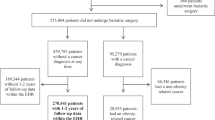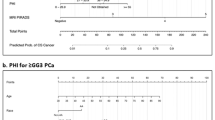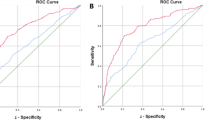Abstract
To clinically apply the inverse PSA–body mass index (BMI) correlation and enhance PSA sensitivity in obese cases, a new formula is warranted. An innovated BMI–PSA equation is designed. PSA–BMI adjusted formula (named Hekal's equation): measured total PSA (ng ml−1) multiplied by age (years) and divided by BMI of the patient. The formula is applied over a randomly chosen 1000 cases of different PSA, BMI, age and trans-rectal ultrasound biopsy results, the yield of new PSA is correlated with pathology and age-specific PSA adjustment values. Among the 988 cases with complete data, obesity (BMI: 30–35 kg m−2) in 236 cases (23.8%) and 79 cases (7.9%) have BMI>35 kg m−2. Mean PSA was 5.8 ng ml−1 (s.d.±8.4 ng ml−1). Cases stratified based on their age (every 10 years). The new equation was applied. Obesity is detected in 33.5 and 43.6% of fifth and sixth decade of life respectively (P=0.02), with low measured PSA values (2.1, 3.8 ng ml−1, respectively). By such PSA measurement biopsy may be omitted, missing 53.3% of malignant cases. In contrast, PSA adjusted were 4 and 9.3 ng ml−1 within the same group of patients. With such values, the decision of a biopsy could not be missed for the targeted groups. Specificity and sensitivity of adjusted PSA values at cutoff point 4 ng ml−1 was 41.7 and 70%, respectively. Based on our results, the new PSA–BMI adjusted formula is reproducible, easy applied formula. With such a formula the higher sensitivity of PSA in obese patients could be achieved. The misleading low PSA in obese cases in the fifth and sixth decade will be corrected.
This is a preview of subscription content, access via your institution
Access options
Subscribe to this journal
Receive 4 print issues and online access
$259.00 per year
only $64.75 per issue
Buy this article
- Purchase on Springer Link
- Instant access to full article PDF
Prices may be subject to local taxes which are calculated during checkout


Similar content being viewed by others
References
Gray MA, Delahunt B, Fowles JR, Weinstein P, Cookes RR, Nacey JN . Demographic and clinical factors as determinants of serum levels of prostate specific antigen and its derivatives. Anticancer Res 2004; 24: 2069–2072.
Ochiai A, Fritsche HA, Babaian RJ . Influence of anthropometric measurements, age, and prostate volume on prostate-specific antigen levels in men with a low risk of prostate cancer. Urology 2005; 66: 819–823.
Kristal AR, Chi C, Tangen CM, Goodman PJ, Etzioni R, Thompson IM . Associations of demographic and lifestyle characteristics with prostate-specific antigen (PSA) concentration and rate of PSA increase. Cancer 2006; 106: 320–328.
Freedland SJ, Wen J, Wuerstle M, Shah A, Lai D, Moalej B et al. Obesity is a significant risk factor for prostate cancer at the time of biopsy. Urology 2008; 72: 1102–1105.
Oesterling JE, Jacobsen SJ, Chute CG, Guess HA, Girman CJ, Panser LA et al. Serum prostate-specific antigen in a community-based population of healthy men. Establishment of age-specific reference ranges. JAMA 1993; 270: 860–864.
National Heart Lung and Blood Institute. Clinical guidelines on the identification, evaluation, and treatment of overweight and obesity in adults—the evidence report. Obes Res 1998; 6 (Suppl 2): 51S–210S.
Ross LE, Coates RJ, Breen N, Uhler RJ, Potosky AL, Blackman D . Prostate specific antigen test use reported in the 2000 National Health Interview Survey. Prev Med 2004; 38: 732–744.
Barqawi AB, Golden BK, O’Donnell C, Brawer MK, Crawford ED . Observed effect of age and body mass index on total and complexed PSA: analysis from a national screening program. Urology 2005; 65: 708–712.
Baillargeon J, Pollock BH, Kristal AR, Bradshaw P, Hernandez J, Basler J et al. The association of body mass index and prostate-specific antigen in a population-based study. Cancer 2005; 103: 1092–1095.
Rodriguez C, Patel AV, Calle EE, Jacobs EJ, Chao A, Thun MJ . Body mass index, height, and prostate cancer mortality in two large cohorts of adult men in the United States. Cancer Epidemiol Biomarkers Prev 2001; 10: 345–353.
Vollmer RT, Humphrey PA . Tumor volume in prostate cancer and serum prostate-specific antigen. Analysis from a kinetic viewpoint. Am J Clin Pathol 2003; 119: 80–89.
Bañez LL, Hamilton RJ, Partin AW, Vollmer RT, Sun L, Rodriguez C et al. Obesity—related plasma hemodilution and PSA concentration among men with prostate cancer. JAMA 2007; 298: 2275–2280.
Moul JW . Words of wisdom. Re: obesity-related plasma hemodilution and PSA concentration among men with prostate cancer. Eur Urol 2008; 54: 232–233.
Buschemeyer III WC, Freedland SJ . Obesity and prostate cancer: epidemiology and clinical implications. Eur Urol 2007; 52: 331–343.
Kim YJ, Han BK, Hong SK, Byun SS, Kim WJ, Lee SE . Body mass index influences prostate-specific antigen in men younger than 60 years of age. Int J Urol 2007; 14: 1009–1012.
Hekal IA . The patients less than 50 years: is there a need to lower the PSA cutoff point? Prostate Cancer Prostatic Dis 2009; 12: 148–151.
Dahle SE, Chokkalingam AP, Gao Y-T, Deng J, Stanczyk FZ, Hsing AW . Body size and serum levels of insulin and leptin in relation to the risk of benign prostatic hyperplasia. J Urol 2002; 168: 599–604.
Hammarsten J, Hogstedt B . Hyperinsulinaemia as a risk factor for developing benign prostatic hyperplasia. Eur Urol 2001; 39: 151–158.
Author information
Authors and Affiliations
Corresponding author
Ethics declarations
Competing interests
The authors declare no conflict of interest.
Appendices
Appendix A

Appendix B

Abbreviations: ng/ml, nanogram per milliliter; BMI, body mass index.
Rights and permissions
About this article
Cite this article
Hekal, I., Ibrahiem, E. Obesity–PSA relationship: a new formula. Prostate Cancer Prostatic Dis 13, 186–190 (2010). https://doi.org/10.1038/pcan.2009.53
Received:
Revised:
Accepted:
Published:
Issue Date:
DOI: https://doi.org/10.1038/pcan.2009.53
Keywords
This article is cited by
-
Assessment of factors associated with PSA level in prostate cancer cases and controls from three geographical regions
Scientific Reports (2022)
-
Clinical management of obese patients with cancer
Nature Reviews Clinical Oncology (2013)
-
Diabetes and prostate cancer risk in the REDUCE trial
Prostate Cancer and Prostatic Diseases (2011)
-
Predictive value of digital rectal examination for prostate cancer detection is modified by obesity
Prostate Cancer and Prostatic Diseases (2011)



